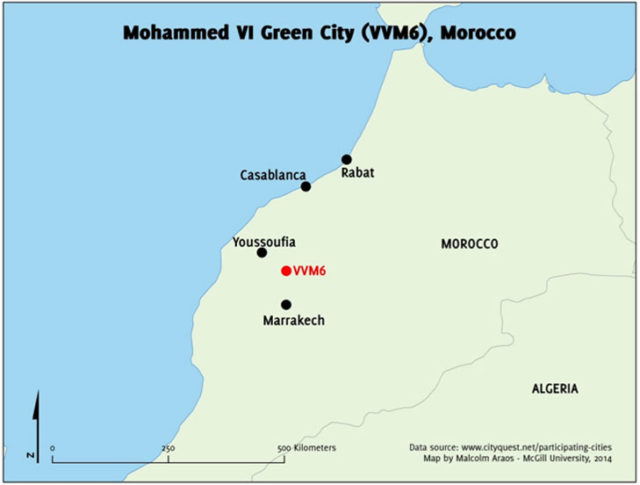Morocco’s New Incubator and Research Hub
décembre 15, 2014 — Uncategorized
King Mohammed VI Green City (VVM6) is the first city-building venture of Office Chérifien des Phosphates (OCP), the world’s largest exporter of phosphate fertilizers. The city is located between Casablanca and Marrakesh, adjacent to Benguerir, an existing city of 80,000 people, which hosts OCP’s second largest operations. The heart of the city will be the University Mohammed VI Polytechnic (UM6P) and the aim is to be a development engine, incubator and research hub centered on universities, and R-&-D activities. The education and research fields are to both benefit from and help OCP’s core business of phosphate fertilizers, and allow more educated Moroccans to participate and expand this area.
VVM6 also seeks to be a ‘green city’, and is experimenting with solar harvesting, given the abundance of consistent sunshine in Morocco.

Key Facts
Date: 2010 – 2040 (approximate – no set completion date as the plan is to develop as the population grows)
Intended population: 120,000
Size: 10 square kilometers
Estimated cost: USD $4.15 billion
Financing strategies: OCP is the primary driver behind VVM6, although they are looking for other financial partners.
Planners / contractors: OCP is the master designer and developer
Environmental and sustainability strategies:
- VVM6 is the first major African project engaging in the LEED-ND (LEED for Neighborhood Development) certification process. They seek to use low-energy materials, employ passive energy strategies and use renewable energy, particularly solar. They are taking advantage of their role as a research and education hub to carry out experimental solar projects designed to take advantage of the abundant sunlight hours in Morocco to power the city. VVM6 has developed a set of standards to force future developers to use solar energy.
- Wind patterns were studied in order to orient VVM6’s master plan so as to reduce the need for air conditioning.
Industries: VVM6’s economy will be centered on several universities, which will ideally spawn an R & D community.
Precedents: Cambridge, Massachusetts is the template for VVM6 and they hope to recreate the energy and dynamism of the Harvard-MIT-Boston University triangle. While Casablanca Finance City is to be a financial hub for Morocco and the region, VVM6 is being designed as the intellectual research hub.
Attractivity: VVM6 is primarily seeking to attract students and professionals involved in the new university and R&-D industries. To attract these groups, VVM6 seeks to create desirable conditions, which in the Moroccan context includes superior urban infrastructure and amenities, full public services from day one, connectivity, competitive living prices, and leisure infrastructure. Building on Morocco’s world famous traditional cities, architecture and urbanism, VVM6 seeks to capture the heritage, beauty, proportions and climate-appropriate features of Moroccan architecture that have developed over the centuries.
Local challenges:
- VVM6 neighbors Benguerir, an 80,000-person working class city with high unemployment, and host to OCP’s second largest mining site. Therefore, there are many challenges relating to social responsibility beyond the new city itself as VVM6 seeks to provide increased services to an existing population with a high unemployment rate.
- Financial challenges: Keeping funding steady while pleasing shareholders, developing the necessary financial structure, attracting new investors, and obtaining government support.
- Regulation is another challenge as power is a state monopoly in Morocco. In order to produce green energy, VVM6 is in negotiations with the Moroccan Authority of Renewable Energy to change Moroccan law so that they may generate their own power within the city.
This post is part of a series tied to Cityquest – KAEC Forum, our leadership event on new cities. Each week, we’ll publish extracts from the report from our inaugural Cityquest event in 2013. Access the full report here.